HI6028 Taxation Theory, Practice and Law Assignment: Analysis
VerifiedAdded on 2022/09/02
|8
|2387
|19
Homework Assignment
AI Summary
This assignment analyzes two taxation issues: the computation of Emmi's taxable income, considering tips, salary, gifts, and entertainment allowances; and the applicability of Capital Gains Tax (CGT) to Liu's transactions, including the sale of a house, car, business, furniture, and paintings. The solution references relevant legislation, including the Income Tax Assessment Act 1997 (ITAA 1997) and ATO guidelines, to determine assessable income and CGT liabilities. The first part calculates Emmi's assessable income, including tips, salary, and entertainment allowance, while excluding gifts. The second part examines Liu's CGT obligations, applying exemptions for main residences, cars, and personal use assets, and considering small business concessions and collectibles. The assignment provides detailed calculations and justifications based on tax laws and regulations.

Running head: INTERNATIONAL FINANCE
Taxation Theory, Practice and Law
Name of the Student
Name of the University
Author Note
Taxation Theory, Practice and Law
Name of the Student
Name of the University
Author Note
Paraphrase This Document
Need a fresh take? Get an instant paraphrase of this document with our AI Paraphraser
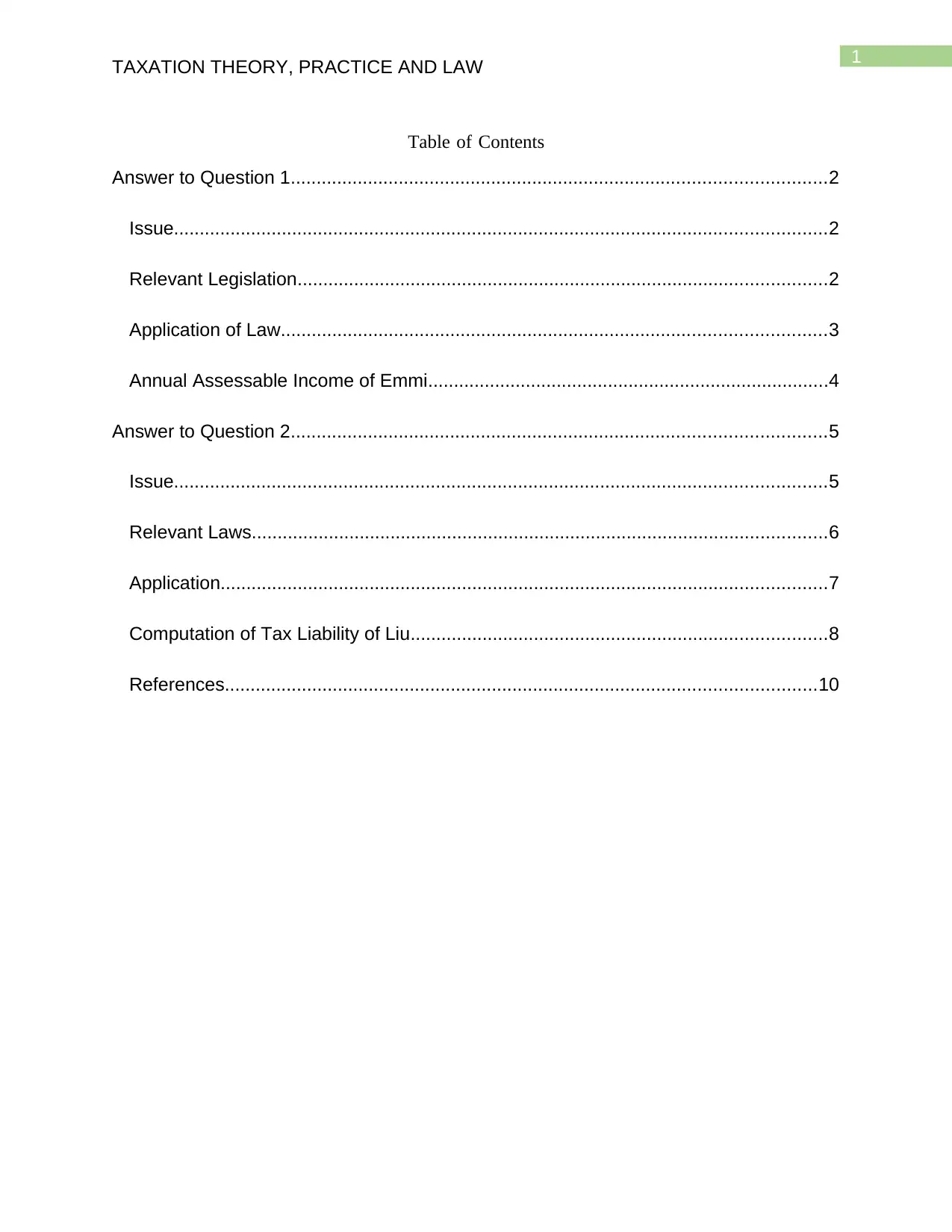
1
TAXATION THEORY, PRACTICE AND LAW
Table of Contents
Answer to Question 1........................................................................................................2
Issue...............................................................................................................................2
Relevant Legislation.......................................................................................................2
Application of Law..........................................................................................................3
Annual Assessable Income of Emmi..............................................................................4
Answer to Question 2........................................................................................................5
Issue...............................................................................................................................5
Relevant Laws................................................................................................................6
Application......................................................................................................................7
Computation of Tax Liability of Liu.................................................................................8
References...................................................................................................................10
TAXATION THEORY, PRACTICE AND LAW
Table of Contents
Answer to Question 1........................................................................................................2
Issue...............................................................................................................................2
Relevant Legislation.......................................................................................................2
Application of Law..........................................................................................................3
Annual Assessable Income of Emmi..............................................................................4
Answer to Question 2........................................................................................................5
Issue...............................................................................................................................5
Relevant Laws................................................................................................................6
Application......................................................................................................................7
Computation of Tax Liability of Liu.................................................................................8
References...................................................................................................................10
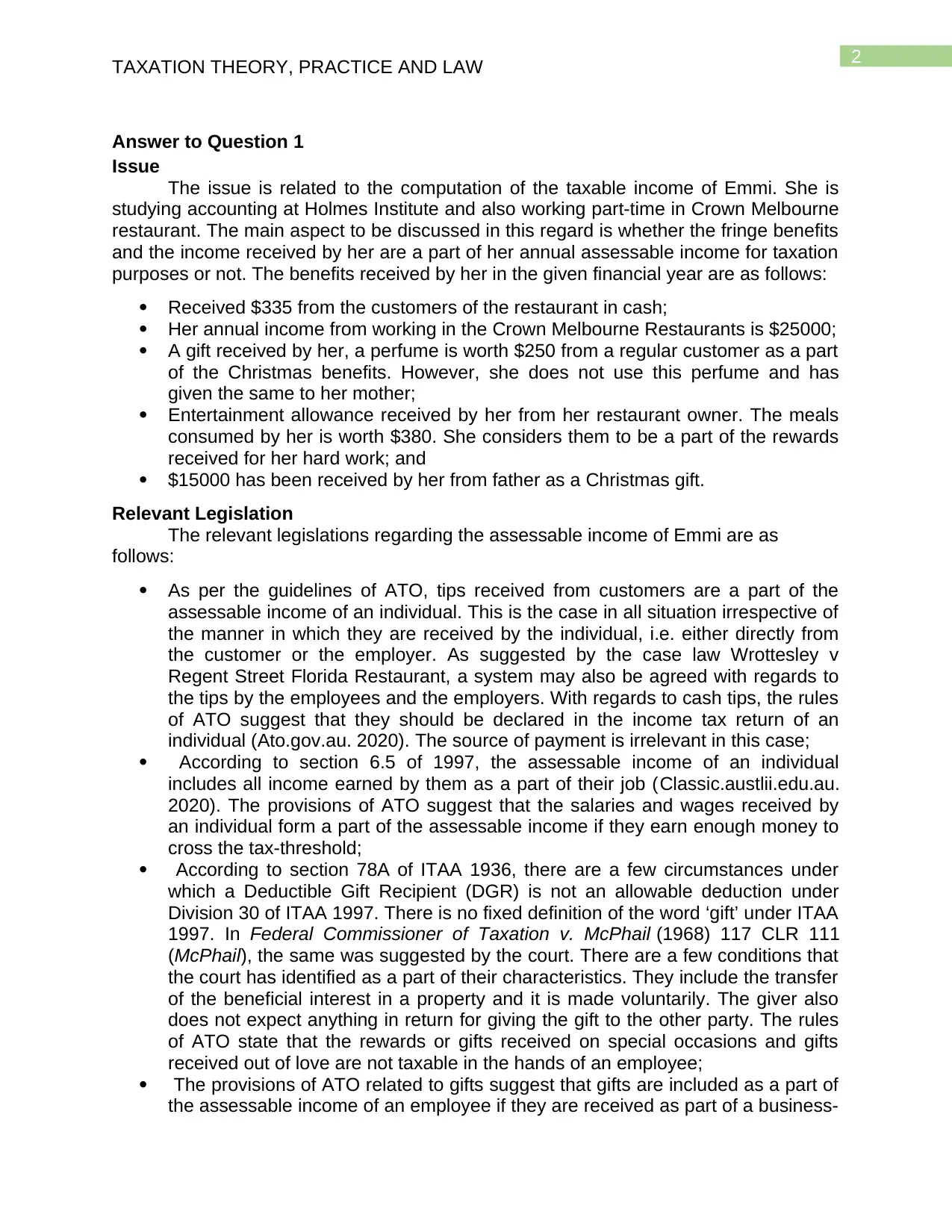
2
TAXATION THEORY, PRACTICE AND LAW
Answer to Question 1
Issue
The issue is related to the computation of the taxable income of Emmi. She is
studying accounting at Holmes Institute and also working part-time in Crown Melbourne
restaurant. The main aspect to be discussed in this regard is whether the fringe benefits
and the income received by her are a part of her annual assessable income for taxation
purposes or not. The benefits received by her in the given financial year are as follows:
Received $335 from the customers of the restaurant in cash;
Her annual income from working in the Crown Melbourne Restaurants is $25000;
A gift received by her, a perfume is worth $250 from a regular customer as a part
of the Christmas benefits. However, she does not use this perfume and has
given the same to her mother;
Entertainment allowance received by her from her restaurant owner. The meals
consumed by her is worth $380. She considers them to be a part of the rewards
received for her hard work; and
$15000 has been received by her from father as a Christmas gift.
Relevant Legislation
The relevant legislations regarding the assessable income of Emmi are as
follows:
As per the guidelines of ATO, tips received from customers are a part of the
assessable income of an individual. This is the case in all situation irrespective of
the manner in which they are received by the individual, i.e. either directly from
the customer or the employer. As suggested by the case law Wrottesley v
Regent Street Florida Restaurant, a system may also be agreed with regards to
the tips by the employees and the employers. With regards to cash tips, the rules
of ATO suggest that they should be declared in the income tax return of an
individual (Ato.gov.au. 2020). The source of payment is irrelevant in this case;
According to section 6.5 of 1997, the assessable income of an individual
includes all income earned by them as a part of their job (Classic.austlii.edu.au.
2020). The provisions of ATO suggest that the salaries and wages received by
an individual form a part of the assessable income if they earn enough money to
cross the tax-threshold;
According to section 78A of ITAA 1936, there are a few circumstances under
which a Deductible Gift Recipient (DGR) is not an allowable deduction under
Division 30 of ITAA 1997. There is no fixed definition of the word ‘gift’ under ITAA
1997. In Federal Commissioner of Taxation v. McPhail (1968) 117 CLR 111
(McPhail), the same was suggested by the court. There are a few conditions that
the court has identified as a part of their characteristics. They include the transfer
of the beneficial interest in a property and it is made voluntarily. The giver also
does not expect anything in return for giving the gift to the other party. The rules
of ATO state that the rewards or gifts received on special occasions and gifts
received out of love are not taxable in the hands of an employee;
The provisions of ATO related to gifts suggest that gifts are included as a part of
the assessable income of an employee if they are received as part of a business-
TAXATION THEORY, PRACTICE AND LAW
Answer to Question 1
Issue
The issue is related to the computation of the taxable income of Emmi. She is
studying accounting at Holmes Institute and also working part-time in Crown Melbourne
restaurant. The main aspect to be discussed in this regard is whether the fringe benefits
and the income received by her are a part of her annual assessable income for taxation
purposes or not. The benefits received by her in the given financial year are as follows:
Received $335 from the customers of the restaurant in cash;
Her annual income from working in the Crown Melbourne Restaurants is $25000;
A gift received by her, a perfume is worth $250 from a regular customer as a part
of the Christmas benefits. However, she does not use this perfume and has
given the same to her mother;
Entertainment allowance received by her from her restaurant owner. The meals
consumed by her is worth $380. She considers them to be a part of the rewards
received for her hard work; and
$15000 has been received by her from father as a Christmas gift.
Relevant Legislation
The relevant legislations regarding the assessable income of Emmi are as
follows:
As per the guidelines of ATO, tips received from customers are a part of the
assessable income of an individual. This is the case in all situation irrespective of
the manner in which they are received by the individual, i.e. either directly from
the customer or the employer. As suggested by the case law Wrottesley v
Regent Street Florida Restaurant, a system may also be agreed with regards to
the tips by the employees and the employers. With regards to cash tips, the rules
of ATO suggest that they should be declared in the income tax return of an
individual (Ato.gov.au. 2020). The source of payment is irrelevant in this case;
According to section 6.5 of 1997, the assessable income of an individual
includes all income earned by them as a part of their job (Classic.austlii.edu.au.
2020). The provisions of ATO suggest that the salaries and wages received by
an individual form a part of the assessable income if they earn enough money to
cross the tax-threshold;
According to section 78A of ITAA 1936, there are a few circumstances under
which a Deductible Gift Recipient (DGR) is not an allowable deduction under
Division 30 of ITAA 1997. There is no fixed definition of the word ‘gift’ under ITAA
1997. In Federal Commissioner of Taxation v. McPhail (1968) 117 CLR 111
(McPhail), the same was suggested by the court. There are a few conditions that
the court has identified as a part of their characteristics. They include the transfer
of the beneficial interest in a property and it is made voluntarily. The giver also
does not expect anything in return for giving the gift to the other party. The rules
of ATO state that the rewards or gifts received on special occasions and gifts
received out of love are not taxable in the hands of an employee;
The provisions of ATO related to gifts suggest that gifts are included as a part of
the assessable income of an employee if they are received as part of a business-
⊘ This is a preview!⊘
Do you want full access?
Subscribe today to unlock all pages.

Trusted by 1+ million students worldwide
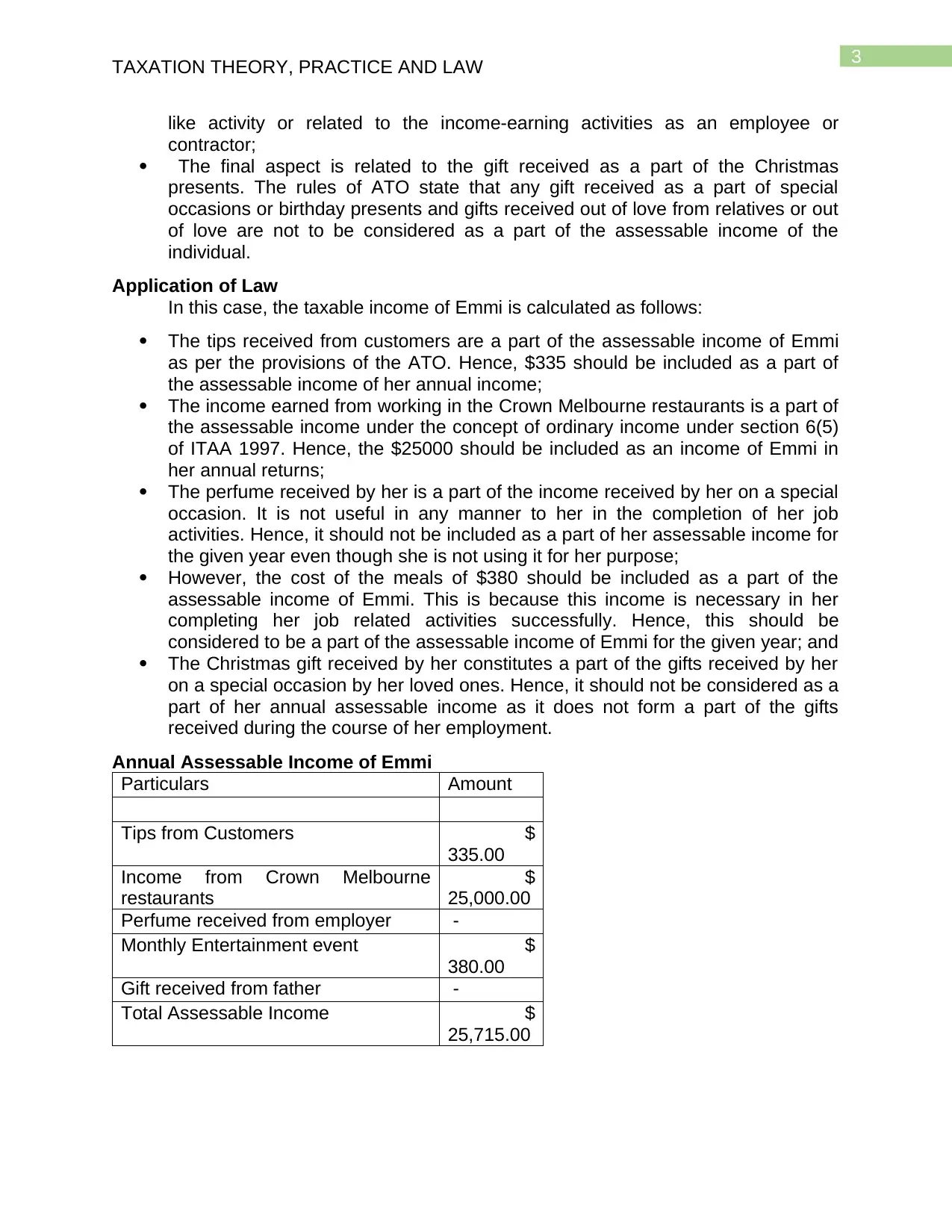
3
TAXATION THEORY, PRACTICE AND LAW
like activity or related to the income-earning activities as an employee or
contractor;
The final aspect is related to the gift received as a part of the Christmas
presents. The rules of ATO state that any gift received as a part of special
occasions or birthday presents and gifts received out of love from relatives or out
of love are not to be considered as a part of the assessable income of the
individual.
Application of Law
In this case, the taxable income of Emmi is calculated as follows:
The tips received from customers are a part of the assessable income of Emmi
as per the provisions of the ATO. Hence, $335 should be included as a part of
the assessable income of her annual income;
The income earned from working in the Crown Melbourne restaurants is a part of
the assessable income under the concept of ordinary income under section 6(5)
of ITAA 1997. Hence, the $25000 should be included as an income of Emmi in
her annual returns;
The perfume received by her is a part of the income received by her on a special
occasion. It is not useful in any manner to her in the completion of her job
activities. Hence, it should not be included as a part of her assessable income for
the given year even though she is not using it for her purpose;
However, the cost of the meals of $380 should be included as a part of the
assessable income of Emmi. This is because this income is necessary in her
completing her job related activities successfully. Hence, this should be
considered to be a part of the assessable income of Emmi for the given year; and
The Christmas gift received by her constitutes a part of the gifts received by her
on a special occasion by her loved ones. Hence, it should not be considered as a
part of her annual assessable income as it does not form a part of the gifts
received during the course of her employment.
Annual Assessable Income of Emmi
Particulars Amount
Tips from Customers $
335.00
Income from Crown Melbourne
restaurants
$
25,000.00
Perfume received from employer -
Monthly Entertainment event $
380.00
Gift received from father -
Total Assessable Income $
25,715.00
TAXATION THEORY, PRACTICE AND LAW
like activity or related to the income-earning activities as an employee or
contractor;
The final aspect is related to the gift received as a part of the Christmas
presents. The rules of ATO state that any gift received as a part of special
occasions or birthday presents and gifts received out of love from relatives or out
of love are not to be considered as a part of the assessable income of the
individual.
Application of Law
In this case, the taxable income of Emmi is calculated as follows:
The tips received from customers are a part of the assessable income of Emmi
as per the provisions of the ATO. Hence, $335 should be included as a part of
the assessable income of her annual income;
The income earned from working in the Crown Melbourne restaurants is a part of
the assessable income under the concept of ordinary income under section 6(5)
of ITAA 1997. Hence, the $25000 should be included as an income of Emmi in
her annual returns;
The perfume received by her is a part of the income received by her on a special
occasion. It is not useful in any manner to her in the completion of her job
activities. Hence, it should not be included as a part of her assessable income for
the given year even though she is not using it for her purpose;
However, the cost of the meals of $380 should be included as a part of the
assessable income of Emmi. This is because this income is necessary in her
completing her job related activities successfully. Hence, this should be
considered to be a part of the assessable income of Emmi for the given year; and
The Christmas gift received by her constitutes a part of the gifts received by her
on a special occasion by her loved ones. Hence, it should not be considered as a
part of her annual assessable income as it does not form a part of the gifts
received during the course of her employment.
Annual Assessable Income of Emmi
Particulars Amount
Tips from Customers $
335.00
Income from Crown Melbourne
restaurants
$
25,000.00
Perfume received from employer -
Monthly Entertainment event $
380.00
Gift received from father -
Total Assessable Income $
25,715.00
Paraphrase This Document
Need a fresh take? Get an instant paraphrase of this document with our AI Paraphraser
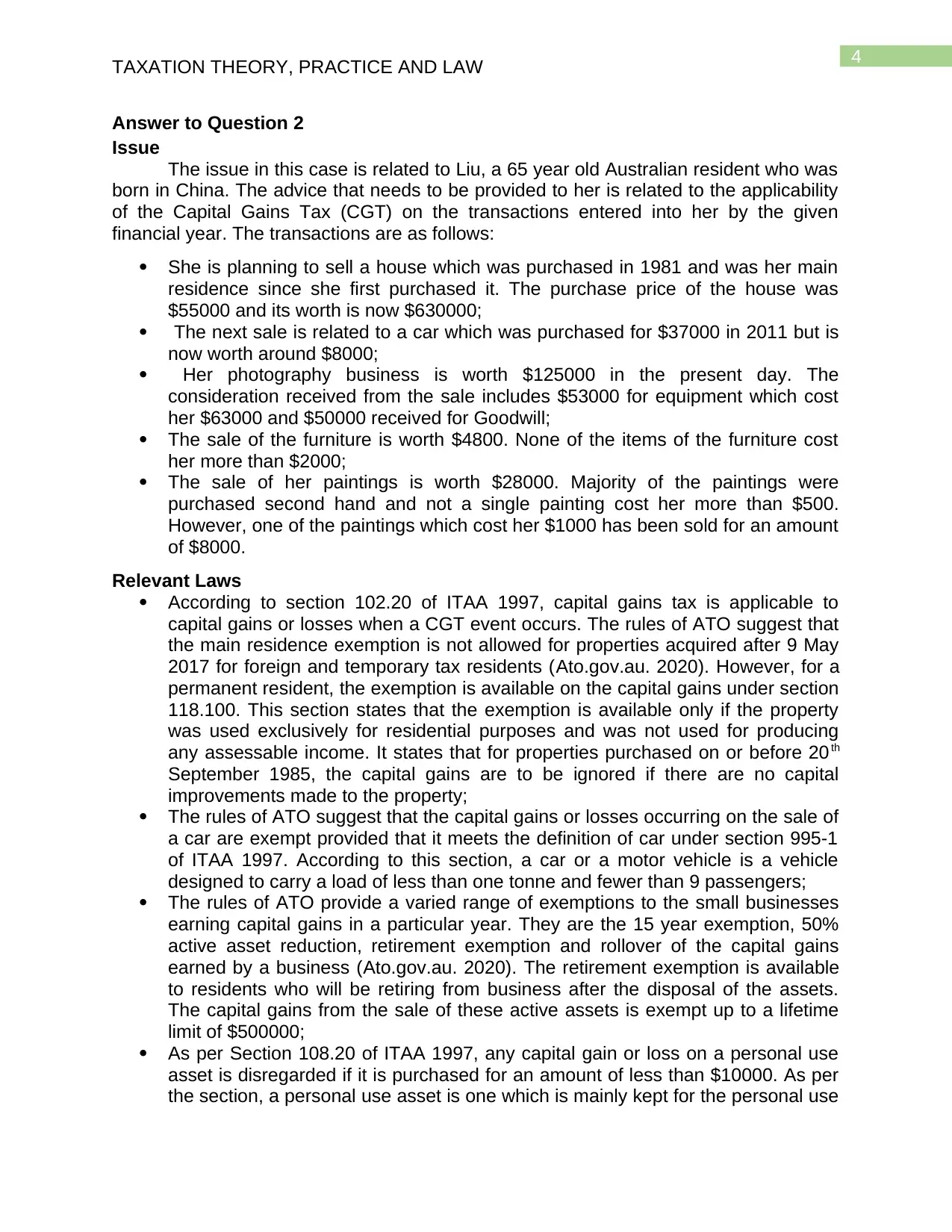
4
TAXATION THEORY, PRACTICE AND LAW
Answer to Question 2
Issue
The issue in this case is related to Liu, a 65 year old Australian resident who was
born in China. The advice that needs to be provided to her is related to the applicability
of the Capital Gains Tax (CGT) on the transactions entered into her by the given
financial year. The transactions are as follows:
She is planning to sell a house which was purchased in 1981 and was her main
residence since she first purchased it. The purchase price of the house was
$55000 and its worth is now $630000;
The next sale is related to a car which was purchased for $37000 in 2011 but is
now worth around $8000;
Her photography business is worth $125000 in the present day. The
consideration received from the sale includes $53000 for equipment which cost
her $63000 and $50000 received for Goodwill;
The sale of the furniture is worth $4800. None of the items of the furniture cost
her more than $2000;
The sale of her paintings is worth $28000. Majority of the paintings were
purchased second hand and not a single painting cost her more than $500.
However, one of the paintings which cost her $1000 has been sold for an amount
of $8000.
Relevant Laws
According to section 102.20 of ITAA 1997, capital gains tax is applicable to
capital gains or losses when a CGT event occurs. The rules of ATO suggest that
the main residence exemption is not allowed for properties acquired after 9 May
2017 for foreign and temporary tax residents (Ato.gov.au. 2020). However, for a
permanent resident, the exemption is available on the capital gains under section
118.100. This section states that the exemption is available only if the property
was used exclusively for residential purposes and was not used for producing
any assessable income. It states that for properties purchased on or before 20th
September 1985, the capital gains are to be ignored if there are no capital
improvements made to the property;
The rules of ATO suggest that the capital gains or losses occurring on the sale of
a car are exempt provided that it meets the definition of car under section 995-1
of ITAA 1997. According to this section, a car or a motor vehicle is a vehicle
designed to carry a load of less than one tonne and fewer than 9 passengers;
The rules of ATO provide a varied range of exemptions to the small businesses
earning capital gains in a particular year. They are the 15 year exemption, 50%
active asset reduction, retirement exemption and rollover of the capital gains
earned by a business (Ato.gov.au. 2020). The retirement exemption is available
to residents who will be retiring from business after the disposal of the assets.
The capital gains from the sale of these active assets is exempt up to a lifetime
limit of $500000;
As per Section 108.20 of ITAA 1997, any capital gain or loss on a personal use
asset is disregarded if it is purchased for an amount of less than $10000. As per
the section, a personal use asset is one which is mainly kept for the personal use
TAXATION THEORY, PRACTICE AND LAW
Answer to Question 2
Issue
The issue in this case is related to Liu, a 65 year old Australian resident who was
born in China. The advice that needs to be provided to her is related to the applicability
of the Capital Gains Tax (CGT) on the transactions entered into her by the given
financial year. The transactions are as follows:
She is planning to sell a house which was purchased in 1981 and was her main
residence since she first purchased it. The purchase price of the house was
$55000 and its worth is now $630000;
The next sale is related to a car which was purchased for $37000 in 2011 but is
now worth around $8000;
Her photography business is worth $125000 in the present day. The
consideration received from the sale includes $53000 for equipment which cost
her $63000 and $50000 received for Goodwill;
The sale of the furniture is worth $4800. None of the items of the furniture cost
her more than $2000;
The sale of her paintings is worth $28000. Majority of the paintings were
purchased second hand and not a single painting cost her more than $500.
However, one of the paintings which cost her $1000 has been sold for an amount
of $8000.
Relevant Laws
According to section 102.20 of ITAA 1997, capital gains tax is applicable to
capital gains or losses when a CGT event occurs. The rules of ATO suggest that
the main residence exemption is not allowed for properties acquired after 9 May
2017 for foreign and temporary tax residents (Ato.gov.au. 2020). However, for a
permanent resident, the exemption is available on the capital gains under section
118.100. This section states that the exemption is available only if the property
was used exclusively for residential purposes and was not used for producing
any assessable income. It states that for properties purchased on or before 20th
September 1985, the capital gains are to be ignored if there are no capital
improvements made to the property;
The rules of ATO suggest that the capital gains or losses occurring on the sale of
a car are exempt provided that it meets the definition of car under section 995-1
of ITAA 1997. According to this section, a car or a motor vehicle is a vehicle
designed to carry a load of less than one tonne and fewer than 9 passengers;
The rules of ATO provide a varied range of exemptions to the small businesses
earning capital gains in a particular year. They are the 15 year exemption, 50%
active asset reduction, retirement exemption and rollover of the capital gains
earned by a business (Ato.gov.au. 2020). The retirement exemption is available
to residents who will be retiring from business after the disposal of the assets.
The capital gains from the sale of these active assets is exempt up to a lifetime
limit of $500000;
As per Section 108.20 of ITAA 1997, any capital gain or loss on a personal use
asset is disregarded if it is purchased for an amount of less than $10000. As per
the section, a personal use asset is one which is mainly kept for the personal use
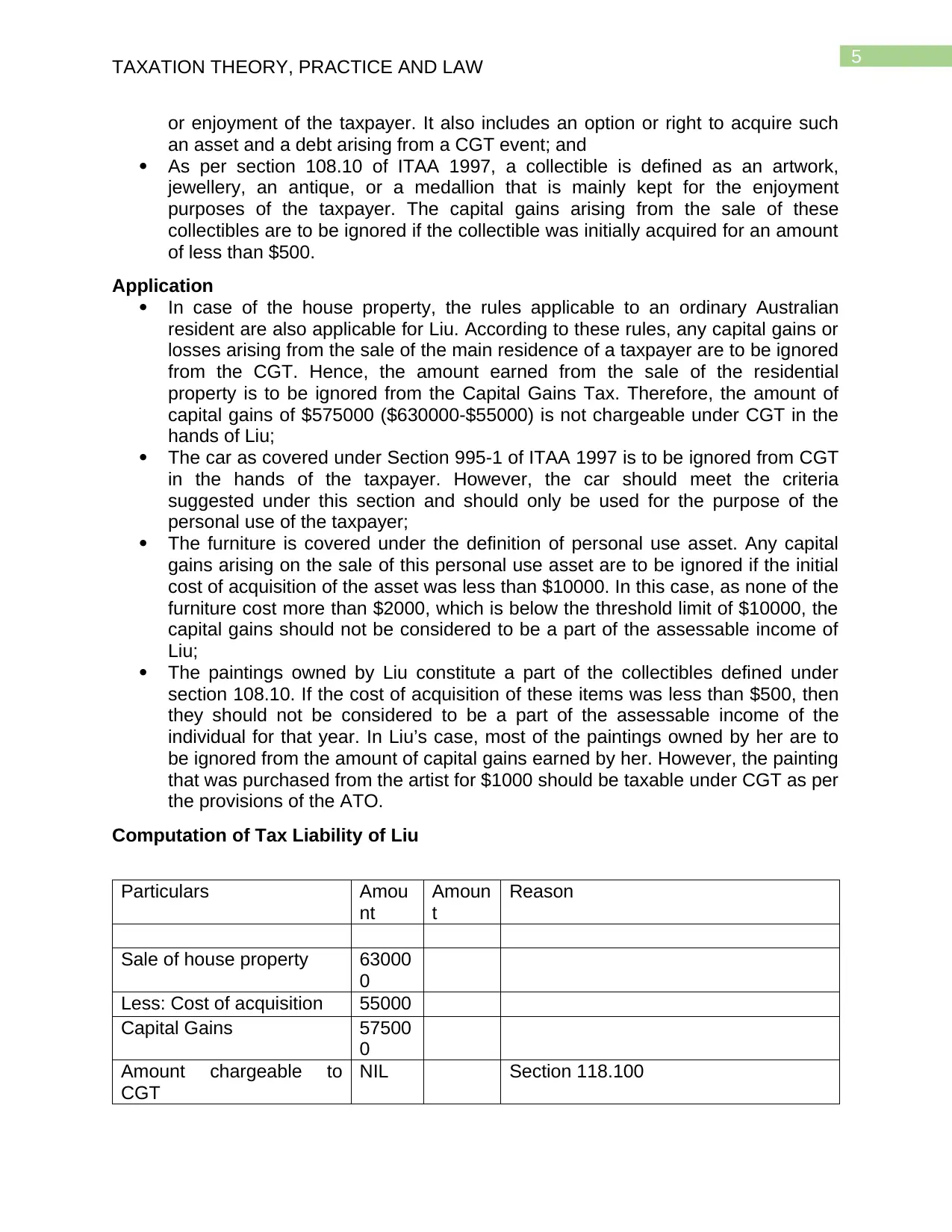
5
TAXATION THEORY, PRACTICE AND LAW
or enjoyment of the taxpayer. It also includes an option or right to acquire such
an asset and a debt arising from a CGT event; and
As per section 108.10 of ITAA 1997, a collectible is defined as an artwork,
jewellery, an antique, or a medallion that is mainly kept for the enjoyment
purposes of the taxpayer. The capital gains arising from the sale of these
collectibles are to be ignored if the collectible was initially acquired for an amount
of less than $500.
Application
In case of the house property, the rules applicable to an ordinary Australian
resident are also applicable for Liu. According to these rules, any capital gains or
losses arising from the sale of the main residence of a taxpayer are to be ignored
from the CGT. Hence, the amount earned from the sale of the residential
property is to be ignored from the Capital Gains Tax. Therefore, the amount of
capital gains of $575000 ($630000-$55000) is not chargeable under CGT in the
hands of Liu;
The car as covered under Section 995-1 of ITAA 1997 is to be ignored from CGT
in the hands of the taxpayer. However, the car should meet the criteria
suggested under this section and should only be used for the purpose of the
personal use of the taxpayer;
The furniture is covered under the definition of personal use asset. Any capital
gains arising on the sale of this personal use asset are to be ignored if the initial
cost of acquisition of the asset was less than $10000. In this case, as none of the
furniture cost more than $2000, which is below the threshold limit of $10000, the
capital gains should not be considered to be a part of the assessable income of
Liu;
The paintings owned by Liu constitute a part of the collectibles defined under
section 108.10. If the cost of acquisition of these items was less than $500, then
they should not be considered to be a part of the assessable income of the
individual for that year. In Liu’s case, most of the paintings owned by her are to
be ignored from the amount of capital gains earned by her. However, the painting
that was purchased from the artist for $1000 should be taxable under CGT as per
the provisions of the ATO.
Computation of Tax Liability of Liu
Particulars Amou
nt
Amoun
t
Reason
Sale of house property 63000
0
Less: Cost of acquisition 55000
Capital Gains 57500
0
Amount chargeable to
CGT
NIL Section 118.100
TAXATION THEORY, PRACTICE AND LAW
or enjoyment of the taxpayer. It also includes an option or right to acquire such
an asset and a debt arising from a CGT event; and
As per section 108.10 of ITAA 1997, a collectible is defined as an artwork,
jewellery, an antique, or a medallion that is mainly kept for the enjoyment
purposes of the taxpayer. The capital gains arising from the sale of these
collectibles are to be ignored if the collectible was initially acquired for an amount
of less than $500.
Application
In case of the house property, the rules applicable to an ordinary Australian
resident are also applicable for Liu. According to these rules, any capital gains or
losses arising from the sale of the main residence of a taxpayer are to be ignored
from the CGT. Hence, the amount earned from the sale of the residential
property is to be ignored from the Capital Gains Tax. Therefore, the amount of
capital gains of $575000 ($630000-$55000) is not chargeable under CGT in the
hands of Liu;
The car as covered under Section 995-1 of ITAA 1997 is to be ignored from CGT
in the hands of the taxpayer. However, the car should meet the criteria
suggested under this section and should only be used for the purpose of the
personal use of the taxpayer;
The furniture is covered under the definition of personal use asset. Any capital
gains arising on the sale of this personal use asset are to be ignored if the initial
cost of acquisition of the asset was less than $10000. In this case, as none of the
furniture cost more than $2000, which is below the threshold limit of $10000, the
capital gains should not be considered to be a part of the assessable income of
Liu;
The paintings owned by Liu constitute a part of the collectibles defined under
section 108.10. If the cost of acquisition of these items was less than $500, then
they should not be considered to be a part of the assessable income of the
individual for that year. In Liu’s case, most of the paintings owned by her are to
be ignored from the amount of capital gains earned by her. However, the painting
that was purchased from the artist for $1000 should be taxable under CGT as per
the provisions of the ATO.
Computation of Tax Liability of Liu
Particulars Amou
nt
Amoun
t
Reason
Sale of house property 63000
0
Less: Cost of acquisition 55000
Capital Gains 57500
0
Amount chargeable to
CGT
NIL Section 118.100
⊘ This is a preview!⊘
Do you want full access?
Subscribe today to unlock all pages.

Trusted by 1+ million students worldwide
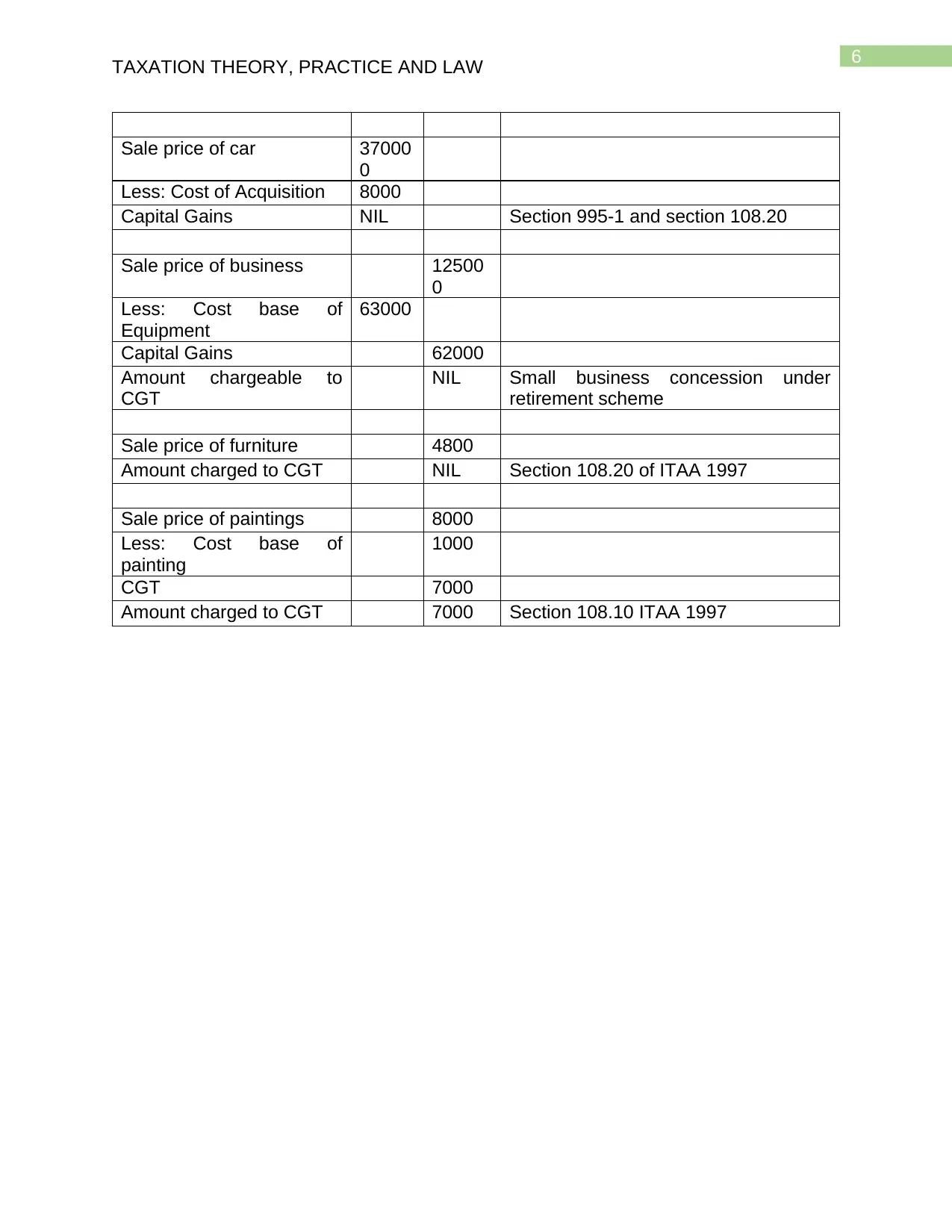
6
TAXATION THEORY, PRACTICE AND LAW
Sale price of car 37000
0
Less: Cost of Acquisition 8000
Capital Gains NIL Section 995-1 and section 108.20
Sale price of business 12500
0
Less: Cost base of
Equipment
63000
Capital Gains 62000
Amount chargeable to
CGT
NIL Small business concession under
retirement scheme
Sale price of furniture 4800
Amount charged to CGT NIL Section 108.20 of ITAA 1997
Sale price of paintings 8000
Less: Cost base of
painting
1000
CGT 7000
Amount charged to CGT 7000 Section 108.10 ITAA 1997
TAXATION THEORY, PRACTICE AND LAW
Sale price of car 37000
0
Less: Cost of Acquisition 8000
Capital Gains NIL Section 995-1 and section 108.20
Sale price of business 12500
0
Less: Cost base of
Equipment
63000
Capital Gains 62000
Amount chargeable to
CGT
NIL Small business concession under
retirement scheme
Sale price of furniture 4800
Amount charged to CGT NIL Section 108.20 of ITAA 1997
Sale price of paintings 8000
Less: Cost base of
painting
1000
CGT 7000
Amount charged to CGT 7000 Section 108.10 ITAA 1997
Paraphrase This Document
Need a fresh take? Get an instant paraphrase of this document with our AI Paraphraser
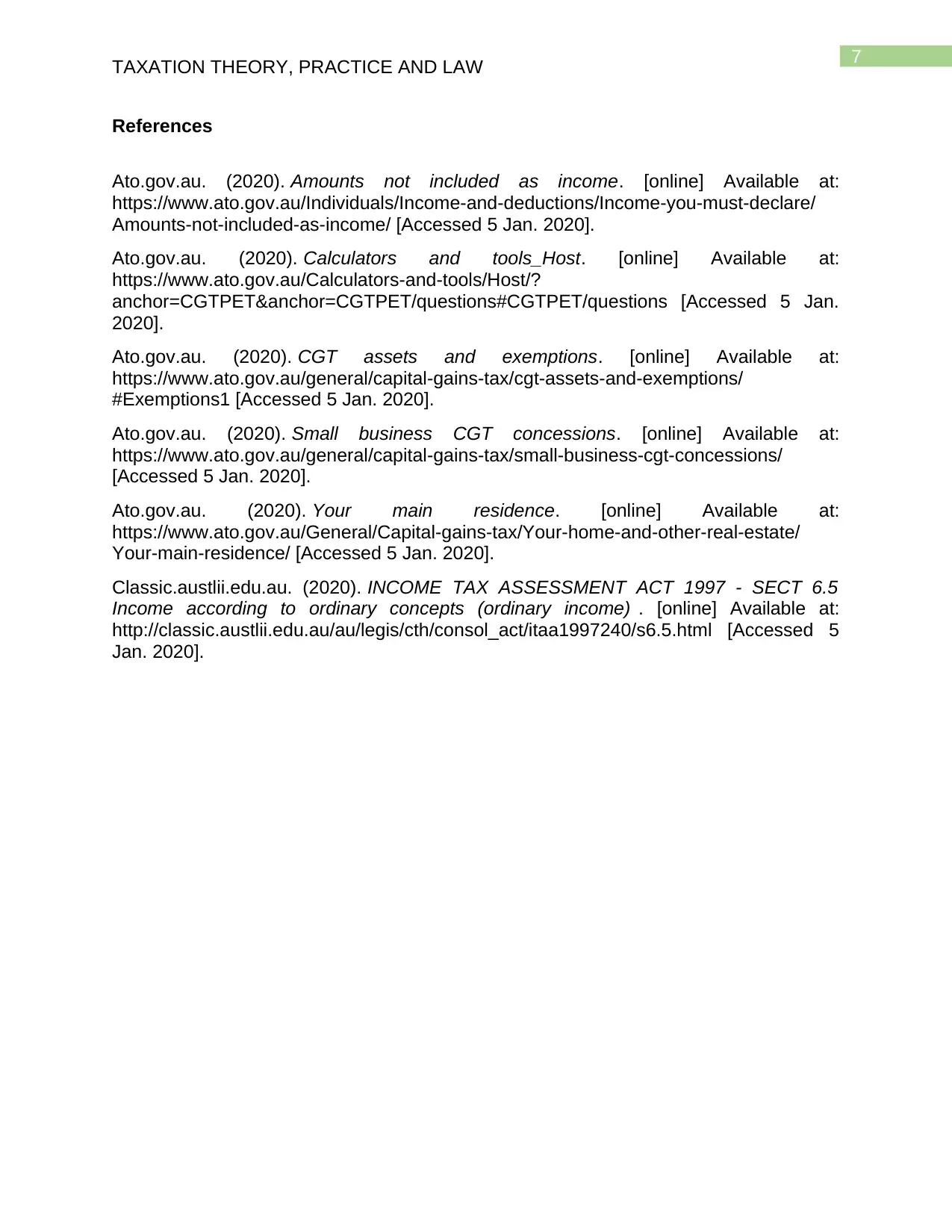
7
TAXATION THEORY, PRACTICE AND LAW
References
Ato.gov.au. (2020). Amounts not included as income. [online] Available at:
https://www.ato.gov.au/Individuals/Income-and-deductions/Income-you-must-declare/
Amounts-not-included-as-income/ [Accessed 5 Jan. 2020].
Ato.gov.au. (2020). Calculators and tools_Host. [online] Available at:
https://www.ato.gov.au/Calculators-and-tools/Host/?
anchor=CGTPET&anchor=CGTPET/questions#CGTPET/questions [Accessed 5 Jan.
2020].
Ato.gov.au. (2020). CGT assets and exemptions. [online] Available at:
https://www.ato.gov.au/general/capital-gains-tax/cgt-assets-and-exemptions/
#Exemptions1 [Accessed 5 Jan. 2020].
Ato.gov.au. (2020). Small business CGT concessions. [online] Available at:
https://www.ato.gov.au/general/capital-gains-tax/small-business-cgt-concessions/
[Accessed 5 Jan. 2020].
Ato.gov.au. (2020). Your main residence. [online] Available at:
https://www.ato.gov.au/General/Capital-gains-tax/Your-home-and-other-real-estate/
Your-main-residence/ [Accessed 5 Jan. 2020].
Classic.austlii.edu.au. (2020). INCOME TAX ASSESSMENT ACT 1997 - SECT 6.5
Income according to ordinary concepts (ordinary income) . [online] Available at:
http://classic.austlii.edu.au/au/legis/cth/consol_act/itaa1997240/s6.5.html [Accessed 5
Jan. 2020].
TAXATION THEORY, PRACTICE AND LAW
References
Ato.gov.au. (2020). Amounts not included as income. [online] Available at:
https://www.ato.gov.au/Individuals/Income-and-deductions/Income-you-must-declare/
Amounts-not-included-as-income/ [Accessed 5 Jan. 2020].
Ato.gov.au. (2020). Calculators and tools_Host. [online] Available at:
https://www.ato.gov.au/Calculators-and-tools/Host/?
anchor=CGTPET&anchor=CGTPET/questions#CGTPET/questions [Accessed 5 Jan.
2020].
Ato.gov.au. (2020). CGT assets and exemptions. [online] Available at:
https://www.ato.gov.au/general/capital-gains-tax/cgt-assets-and-exemptions/
#Exemptions1 [Accessed 5 Jan. 2020].
Ato.gov.au. (2020). Small business CGT concessions. [online] Available at:
https://www.ato.gov.au/general/capital-gains-tax/small-business-cgt-concessions/
[Accessed 5 Jan. 2020].
Ato.gov.au. (2020). Your main residence. [online] Available at:
https://www.ato.gov.au/General/Capital-gains-tax/Your-home-and-other-real-estate/
Your-main-residence/ [Accessed 5 Jan. 2020].
Classic.austlii.edu.au. (2020). INCOME TAX ASSESSMENT ACT 1997 - SECT 6.5
Income according to ordinary concepts (ordinary income) . [online] Available at:
http://classic.austlii.edu.au/au/legis/cth/consol_act/itaa1997240/s6.5.html [Accessed 5
Jan. 2020].
1 out of 8
Related Documents
Your All-in-One AI-Powered Toolkit for Academic Success.
+13062052269
info@desklib.com
Available 24*7 on WhatsApp / Email
![[object Object]](/_next/static/media/star-bottom.7253800d.svg)
Unlock your academic potential
Copyright © 2020–2025 A2Z Services. All Rights Reserved. Developed and managed by ZUCOL.





